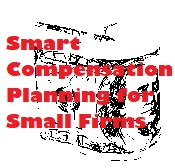Note: This is the second in a 4-part series on compensation practices for small companies. In this series Margaret O’Hanlon shows how a small company typically deals with compensation, discussing each of a few key practices and what problems these may create as the company grows. She offers her insights on how to improve these practices to avoid difficulties as the company expands from under 100 employees to 1,000. Each installment of the series will be published on successive Tuesdays.
“If you can learn from what others have done who were in your shoes, your program design decisions could be favorably influenced . . . and you can go home many more weekends feeling confident that you’re an effective HR leader.”
A great motto for this series! So let’s look at what can be learned from the case study of a start-up that quickly grows into a thriving mid-sized company. We’ll identify some of their missteps — common to companies their size — then discuss what they can do to achieve healthy compensation habits.
Case background: In the first article, we looked at the compensation habits of a company called Healthy Gadgets, a new medical device company that began with fewer than 100 employees. In today’s article, it’s about 18 months later and they have a new product that’s taking off in the cardiac care market. They have close to 400 employees today, and staffing goals for the year will bring the company up to 473 employees.
HR operating context: Compared to when the company had fewer than 100 employees, the CEO no longer has the bandwidth to make everyday decisions. In turn, the human resources manager has become more visible to employees and more involved in day-to-day operations. However, employees are barely satisfied with human resources current service level because the manager, in her HR department of one, has little time to pay attention to much more than hiring. She is using a contract recruiter for certain key jobs and is currently recruiting for an HR specialist because at this certain point, enough is enough. She’s thinking she should have started campaigning for the HR specialist at around 250 employees — and experience shows she’s correct.
Common compensation practices when a company is growing quickly to at least 500 employees.
Here’s what today holds for HR. Let’s take a look at how “healthy” these habits are turning out to be and the alternatives our HR manager may not realize she has:
Salary administration practices are still quite patchwork since most of the energy goes in to enticing new talent, but managers are more involved in compensation decisions than they have been in the past. Since the company still doesn’t have access to compensation surveys due to their cost, managers often bring HR salary data that they’ve scrounged from the web and Salary.com. If the manager or the recruit is a “squeaky wheel” about the salary, HR may contact the outside recruiter for compensation insights. BTW, annual merit increases have been paid in the past two years.
There are a couple of practices here that need to be highlighted.
- HR and managers are collaborating, which is a good thing, but their collaboration is laying a foundation for future difficulties. HR has not yet briefed managers about industry-standard compensation practices, so managers are unaware how much bubble gum and paper clips go into making these important decisions currently. This vagueness will lead inevitably to manager resistance when industry-standard compensation practices are finally introduced, let alone embarrassment at being party to the less-than-standard practices. Not that managers won’t be happy that there is finally a real process, but they will likely question current salaries vociferously when they’ve found out that they could have been making better compensation decisions.
- Managers are also noticing that their “founding” employees are getting a bit antsy about their pay since they still don’t have any real evidence that they are being paid competitively — even if Healthy Gadgets’ compensation strategy has been to overpay.
None of the practices described in these two bullets above will serve you well in the medium-run. In fact, they could weaken HR’s reputation because of the depth of the compromises being made. So look cost/benefit straight in the eye and stand up to your executives about the $3,000 cost of a good salary survey. You need salary survey data to make real business decisions in HR.
Be sure you are hiring a human resources specialist who can deliver compensation analyst skills. Not just because he or she has received a generalist degree, but also because he or she has completed compensation assignments during recent employment, adding up to at least 40% of work time.
The annual bonus was affected by production outlays for the new product. Employees were informed of the effect of the one-time operating cost — no bonus for them this year. In spite of the historically broad-based nature of the bonus though, executives did receive awards.
Healthy Gadgets may have to do this to keep executive compensation competitive, but a company this size has a pretty flat organization, with execs working closely with professionals. If the company wants a healthy culture, the bonus decision of “haves” and “have nots” should be closely scrutinized.
A strategic move for HR would be to:
- Facilitate a candid discussion of the bonus payment before the decision goes into effect, and
- Bring an alternative or two on employee bonus options or total rewards redesign to the meeting.
Unless Healthy Gadgets’ financial situation is dire, it’s hard to imagine why something shouldn’t be done for employees, especially since they are helping to build the company.
This article was first published on Compensation Cafe.
Here are the other parts of this series:

